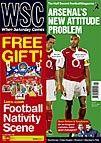 Robbie Meredith reports on how teams from the Republic and Northern Ireland are warming up for a new cross-border competition with some amicable friendlies
Robbie Meredith reports on how teams from the Republic and Northern Ireland are warming up for a new cross-border competition with some amicable friendlies
Appropriately, in an island awash with mythology, the most enduring myth in Irish football is about to be exposed to reality. For a number of years an all-Ireland competition has been prescribed as the cure for the moribund state of domestic football in Ireland, north and south. Now, for the first time since the cross-border Blaxnit Cup was abandoned 25 years ago, competitive all-Ireland football is returning.
The Setanta Cup, to be played in April 2005, brings together the top two clubs from the Republic’s Eircom League and the North’s Irish League, along with the cup winners from both countries. Split into two groups of three, each club will play six matches, with the top team in each group qualifying for the Setanta Cup final. The competition is named after Irish media company Setanta, also broadcasters of the Scottish Premier League, who will televise most games live and supply £900,000 in prize money in a four-year deal, a stellar sum in the impoverished world of Irish football.
Reaction from fans and pundits has been overwhelmingly positive, which is a welcome sign of changing political times. Eircom League side Derry City, based in a Nationalist area of Derry, left the Northern Ireland league in the early Seventies due to strife caused by, and inflicted on, their supporters, while the Blaxnit Cup was abandoned due to fears for the safety of travelling fans at the height of the Troubles. Infrequent – and heavily policed – matches in European competition took place during the Eighties, but friendlies are now commonplace. Linfield, the club most associated with the Protestant Loyalist community in Northern Ireland, have maintained a youth football link with Eircom League side Dundalk for a number of seasons, while Glentoran, the other half of Belfast’s “big two”, recently visited Derry City’s Brandywell ground for the first time in more than 30 years. The match attracted a decent crowd and passed off without incident. Linfield are due to follow soon.
The Setanta Cup has the backing of both Football Associations and all the clubs involved. Pat Fenlon, manager of Eircom League champions Shelbourne, has been especially enthusiastic, which is significant as Fenlon is an emblematic figure in Irish football. One of the first Southern Catholics to sign for Linfield in the wake of the cessation of paramilitary violence in 1994, he had two highly successful years in Belfast.
Shelbourne, in fact, are an emblematic club, and highlight the disparity between the two leagues. The success of the Republic’s national side in the 1990s led to a renewal of interest in domestic football. Irish youngsters returned home to play rather than slog it out in the lower reaches of the English League, while RTE, the Irish state broadcaster, began to cover an increased amount of local football. Crowds and interest increased, in contrast to the North where television coverage remains sparse and many clubs are in debt.
Two seasons ago the players of Shelbourne and Bohemians became full-time professionals and the benefits were illustrated in the summer of 2004 when a narrow away defeat to Deportivo La Coruña denied Shels a Champions League group place. Every club on the island would sell their chairman for similar fortunes and many see the comparative riches available in the Setanta Cup as a chance to follow. However, Setanta’s money may widen inequalities in Irish football. The Northern clubs involved in the inaugural tournament are Linfield, Glentoran and Portadown, by far the richest and best-supported sides in the Irish League. It is already difficult to see any club outside these three winning trophies in the North, and the Setanta Cup will only increase the disparity between the “big three” and the rest.
The story is similar in the South. Shelbourne’s achievements are admirable, but over the past two seasons they, Bohemians and Cork City have pulled away from the other clubs in the Eircom and the new competition will accelerate this process.
Where will it end? Coincidentally, Setanta also televise Celtic League rugby and there is already speculation that a pan-Celtic football league is a long-term aim for the company, encompassing the top Welsh and Irish clubs playing the rump of the Scottish teams, after the Old Firm have cleared off to an English, European or Inter-Galactic championship.
Yet, unusually, Irish football supporters will have a major say in deciding how far things go. Empty terraces do not make good television and it will be interesting to see how long Setanta’s enthusiasm for all-Ireland competition remains if attendances and viewing figures are low. Intense and bitter local rivalry, for better or worse, has sustained Irish football. It remains to be seen whether Linfield v Bohemians will generate the same passion.
From WSC 215 January 2005. What was happening this month